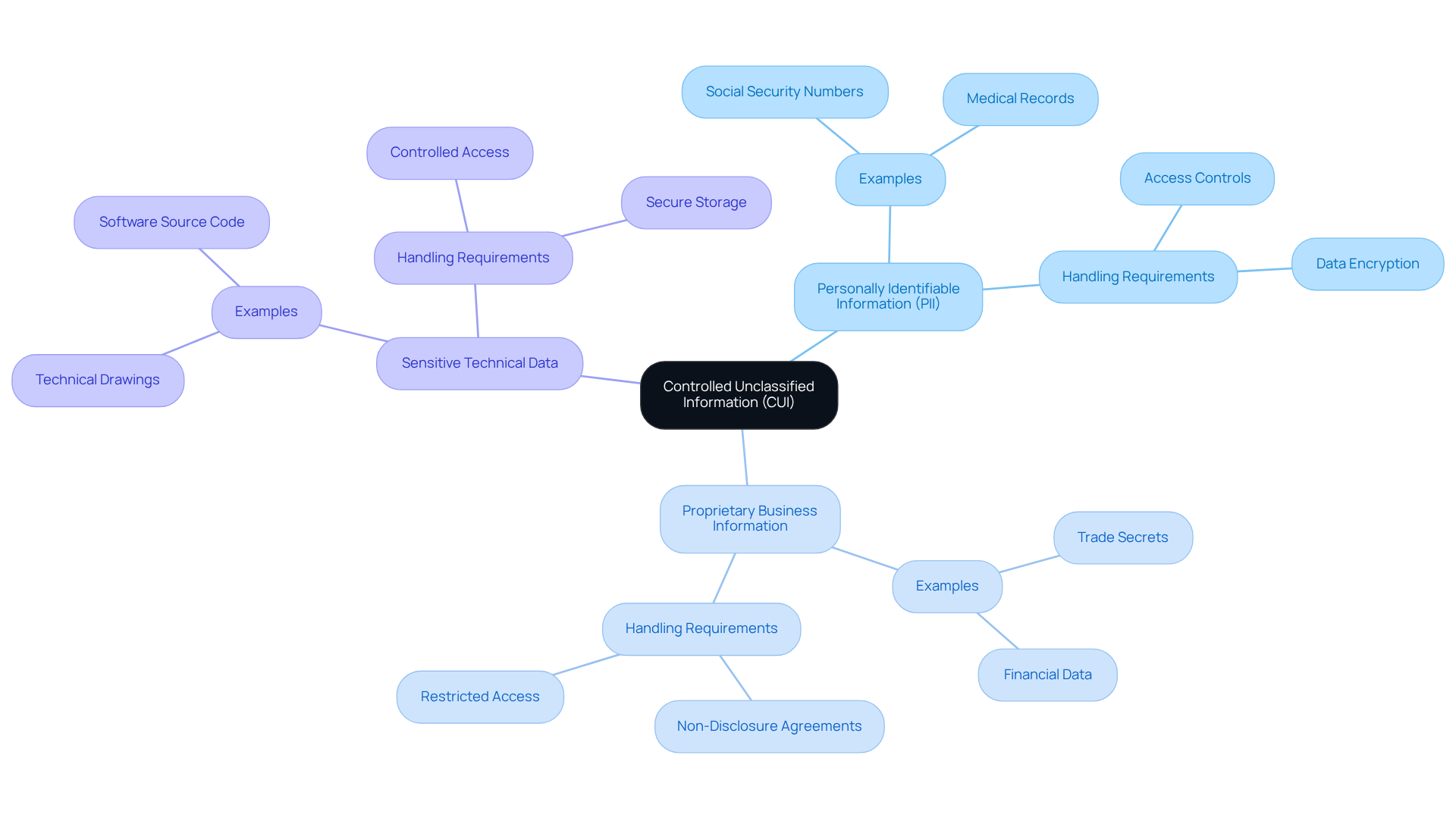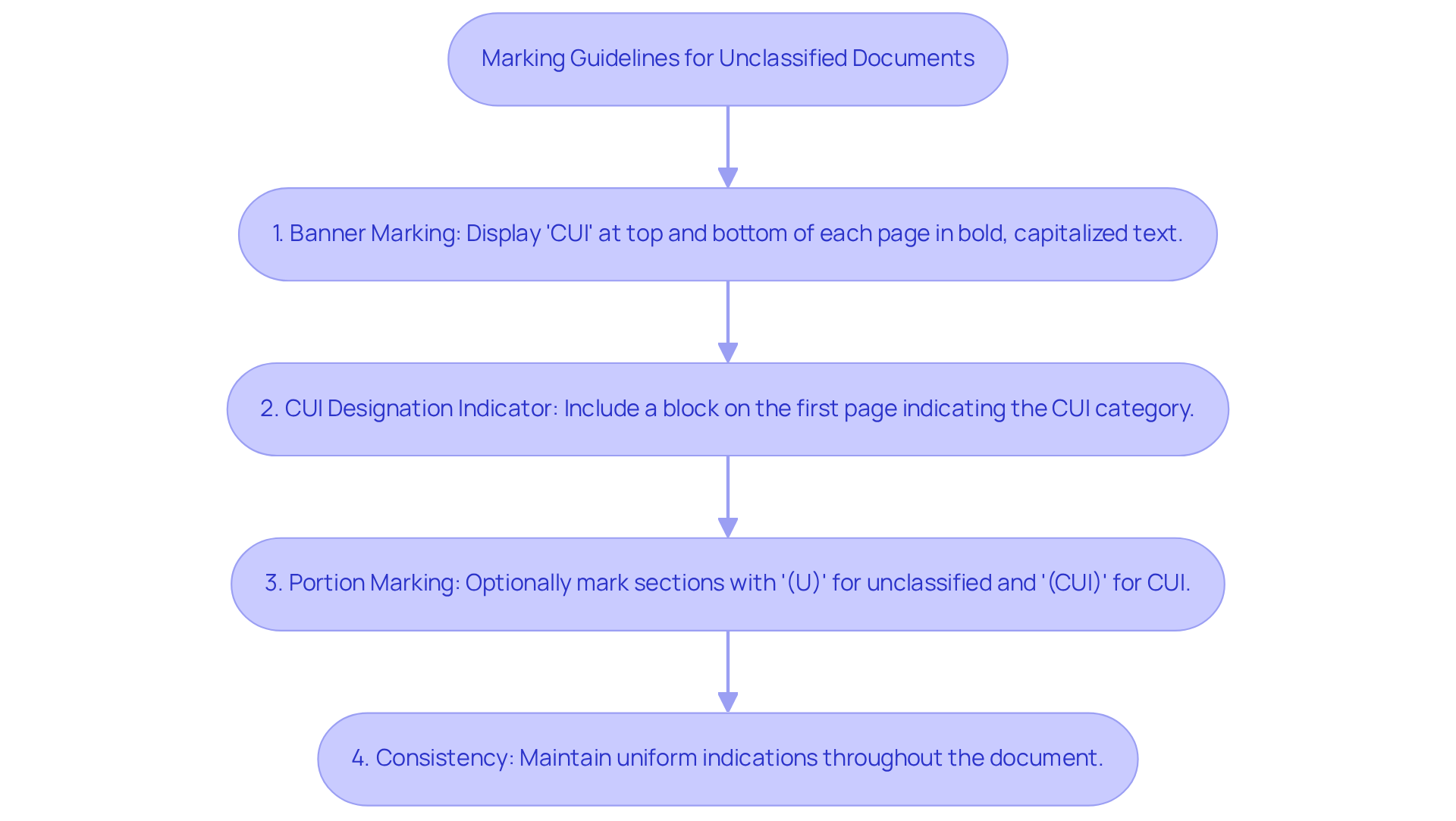Master the Correct Banner Marking for Unclassified Documents with CUI
Learn the correct banner marking for unclassified documents containing CUI.

Overview
This article emphasizes the critical importance of correct banner marking for unclassified documents that contain Controlled Unclassified Information (CUI). Proper labeling is essential for ensuring compliance and enhancing security within organizations. To achieve this, best practices must be followed, including:
- The prominent display of the 'CUI' acronym
- The use of a CUI designation indicator
- Verifying markings through peer reviews and checklists
These steps reinforce the necessity of accurate CUI management to prevent unauthorized disclosure and bolster organizational cybersecurity. Are you ready to implement these practices and safeguard your information?
Introduction
Understanding the nuances of Controlled Unclassified Information (CUI) is essential for organizations tasked with handling sensitive data. Properly marking unclassified documents containing CUI not only ensures compliance with regulatory frameworks but also protects vital information from unauthorized access. However, many organizations grapple with the complexities of CUI marking requirements. This raises a critical question: how can they effectively master the correct banner marking to safeguard their sensitive information and avoid potential repercussions? By addressing these challenges head-on, organizations can enhance their compliance efforts and secure their data.
Understand Controlled Unclassified Information (CUI)
Controlled Unclassified Information (CUI) is a critical concept that refers to unclassified material necessitating safeguarding or dissemination controls as mandated by law, regulation, or government-wide policy. Understanding CUI is paramount, as it encompasses sensitive data that, while not classified, still requires protection to prevent unauthorized access or release. Examples of CUI include:
- Personally identifiable information (PII)
- Proprietary business information
- Sensitive technical data
Familiarity with the CUI categories and their specific handling requirements is essential for compliance with the Cybersecurity Maturity Model Certification (CMMC) and other regulatory frameworks.
The CMMC Info Hub serves as your comprehensive resource for achieving and maintaining CMMC compliance, providing practical solutions and insights that help defense contractors navigate the complexities of CUI management. Alarmingly, a significant percentage of organizations are unaware of the specific CUI categories, emphasizing the urgent need for thorough training and awareness programs. As Ted Schlein aptly states, "there are only two types of companies: those that have been breached and know it, and those that have been breached and don’t know it yet," underscoring the critical importance of effective CUI management. Furthermore, as Stéphane Nappo points out, "cybersecurity is a business imperative," reinforcing the necessity of prioritizing CUI management within organizational strategies.
Key categories of CUI include Controlled Technical Information (CTI), defined under DFARS 7013, along with other sensitive data types that require specific safeguarding measures. By prioritizing the understanding and proper management of CUI, organizations can significantly enhance their cybersecurity posture and ensure compliance with stringent defense contract requirements. For more detailed insights, refer to the DoD CUI Program and explore our FAQs for additional resources.

Follow Marking Guidelines for Unclassified Documents
To properly mark unclassified documents containing Controlled Unclassified Information (CUI), it is essential to adhere to the following best practices:
- Banner Marking: Clearly display the acronym "CUI" at both the top and bottom of each page. Use bold, capitalized text to enhance visibility, ensuring that the marking stands out.
- CUI Designation Indicator: On the first page or cover, include a CUI designation indicator block that specifies the category of CUI, such as 'CUI//PII' for personally identifiable data. This assists recipients in promptly grasping the essence of the details.
- Portion Marking: Although optional, implementing portion markings within the document is advisable. Indicate which sections contain CUI by using notations like "(U)" for unclassified sections and "(CUI)" for those containing controlled unclassified information. This practice enhances clarity and assists in adhering to regulations.
- Consistency: Maintain uniform indications throughout the document, ensuring they accurately reflect the content. Consistency is key to preventing unauthorized disclosure and ensuring that all personnel understand the handling requirements.
CUI is crucial to national defense and requires special protection to prevent unauthorized access. For thorough labeling requirements, consult the CUI Labeling Handbook, which offers detailed instructions on what the correct banner marking for unclassified documents with CUI is. Failure to follow these guidelines may result in administrative, civil, or criminal sanctions for unauthorized disclosure of CUI. By following these practices, organizations can significantly improve their handling of CUI, thereby enhancing compliance with Department of Defense regulations and safeguarding sensitive information.

Verify the Accuracy of Banner Marking
To ensure the accuracy of banner markings on documents containing Controlled Unclassified Information (CUI), follow these essential steps:
-
Review Markings: Confirm that the 'CUI' banner is prominently displayed at both the top and bottom of each page, with the text bolded and capitalized for optimal visibility. This is crucial; studies indicate that approximately 30% of documents in the defense industry fail to meet the correct banner marking for unclassified documents with CUI.
-
Cross-Reference with CUI Registry: Verify that the CUI Designation Indicator (DI) aligns with the information in the document. The CUI DI block should be positioned in the lower right-hand corner or footer of the first page, with a 45-degree diagonal line drawn through it, clearly indicating the name of the person and the date of decontrol. Utilize the CUI Registry to confirm the suitable categories and subcategories, ensuring adherence to established guidelines.
-
Conduct Peer Reviews: Establish a peer review process where a qualified individual evaluates the document for compliance with assessment protocols. Organizations like [Example Corp] have conducted such evaluations, reporting enhanced precision in CUI labels and a significant decrease in adherence mistakes. Auditors emphasize that precise CUI labels are vital for upholding security and compliance, stating, 'Proper labeling is not merely a regulatory obligation; it is a crucial element of protecting sensitive data.'
-
Document Verification: Create a checklist of assessment requirements and ensure each document is verified against this list prior to distribution. This organized method not only improves adherence but also efficiently protects sensitive data.
By diligently following these steps, organizations can significantly enhance their compliance with CUI marking requirements, ensuring that the correct banner marking for unclassified documents with CUI is utilized, thereby bolstering their readiness for defense contracts and safeguarding sensitive information.

Conclusion
Mastering the correct banner marking for unclassified documents containing Controlled Unclassified Information (CUI) is essential for organizations aiming to protect sensitive data while ensuring compliance with regulatory standards. Proper marking not only safeguards information but also communicates the handling requirements to all personnel involved, thereby enhancing overall security protocols.
This guide has underscored the significance of understanding CUI and adhering to marking guidelines. Key practices include:
- Prominently displaying the "CUI" banner
- Utilizing designation indicators
- Ensuring consistency in markings
Furthermore, verifying the accuracy of these markings through peer reviews and cross-referencing with the CUI registry is vital to prevent unauthorized disclosures and maintain compliance with defense contract requirements.
As organizations navigate the complexities of CUI management, it is imperative to prioritize thorough training and awareness initiatives. By doing so, they not only mitigate risks associated with mishandling sensitive information but also strengthen their cybersecurity posture. Embracing these best practices in marking and verifying CUI will contribute to a more secure environment, ultimately supporting the integrity of national defense and compliance with evolving regulations.
Frequently Asked Questions
What is Controlled Unclassified Information (CUI)?
Controlled Unclassified Information (CUI) refers to unclassified material that requires safeguarding or dissemination controls as mandated by law, regulation, or government-wide policy. It encompasses sensitive data that, while not classified, still needs protection to prevent unauthorized access or release.
What are some examples of CUI?
Examples of Controlled Unclassified Information include Personally Identifiable Information (PII), proprietary business information, and sensitive technical data.
Why is understanding CUI important for organizations?
Understanding CUI is crucial for compliance with regulations like the Cybersecurity Maturity Model Certification (CMMC) and for protecting sensitive data from unauthorized access, which can enhance an organization's cybersecurity posture.
What resources are available for achieving CMMC compliance related to CUI?
The CMMC Info Hub serves as a comprehensive resource for achieving and maintaining CMMC compliance, providing practical solutions and insights to help defense contractors manage CUI effectively.
What is the significance of training and awareness programs regarding CUI?
Many organizations are unaware of specific CUI categories, highlighting the urgent need for thorough training and awareness programs to ensure proper management and compliance with regulations.
What is Controlled Technical Information (CTI)?
Controlled Technical Information (CTI) is a key category of CUI defined under DFARS 7013, which includes sensitive data types that require specific safeguarding measures.
How can organizations enhance their cybersecurity posture concerning CUI?
By prioritizing the understanding and proper management of CUI, organizations can significantly improve their cybersecurity posture and ensure compliance with stringent defense contract requirements.




